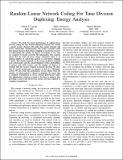Random linear network coding for time division duplexing: energy analysis
Author(s)
Lucani, Daniel Enrique; Medard, Muriel; Stojanovic, Milica
DownloadLucani-2009-Random linear network coding for time division duplexing energy analysis.pdf (191.2Kb)
PUBLISHER_POLICY
Publisher Policy
Article is made available in accordance with the publisher's policy and may be subject to US copyright law. Please refer to the publisher's site for terms of use.
Terms of use
Metadata
Show full item recordAbstract
We study the energy performance of random linear network coding for time division duplexing channels. We assume a packet erasure channel with nodes that cannot transmit and receive information simultaneously. The sender transmits coded data packets back-to-back before stopping to wait for the receiver to acknowledge the number of degrees of freedom, if any, that are required to decode correctly the information. Our analysis shows that, in terms of mean energy consumed, there is an optimal number of coded data packets to send before stopping to listen. This number depends on the energy needed to transmit each coded packet and the acknowledgment (ACK), probabilities of packet and ACK erasure, and the number of degrees of freedom that the receiver requires to decode the data. We show that its energy performance is superior to that of a full-duplex system. We also study the performance of our scheme when the number of coded packets is chosen to minimize the mean time to complete transmission as in. Energy performance under this optimization criterion is found to be close to optimal, thus providing a good trade-off between energy and time required to complete transmissions.
Date issued
2009-08Department
Massachusetts Institute of Technology. Department of Electrical Engineering and Computer Science; Massachusetts Institute of Technology. Research Laboratory of ElectronicsJournal
IEEE International Conference on Communications, 2009. ICC '09
Publisher
Institute of Electrical and Electronics Engineers
Citation
Lucani, D.E., M. Stojanovic, and M. Medard. “Random Linear Network Coding for Time Division Duplexing: Energy Analysis.” Communications, 2009. ICC '09. IEEE International Conference on. 2009. 1-5. © 2009 IEEE.
Version: Final published version
Other identifiers
INSPEC Accession Number: 10815271
ISBN
978-1-4244-3435-0
ISSN
1938-1883